Research - (2020) Advances in Dental Surgery
Knowledge and Awareness on Emerging Infectious Disease Spread among Dental Students
Mukil Sunil1, Preetha S1 and Lavanya Prathap2
Abstract
Emerging infectious diseases (EIDs) are an enormous burden on worldwide economies and public health. Their emergence is thought to be driven in large part by way of socio-economic, environmental, and ecological factors however no comparative looks at has explicitly analyzed those linkages to apprehend worldwide temporal and spatial patterns of EIDs. The aim of the study is to assess the knowledge and awareness on emerging infectious disease spread among dental students. A survey-based questionnaire was done to create knowledge about emerging infectious diseases. A total questionnaire of 11 questions was collected by Google forms and the data was analyzed by SPSS software. The overall awareness of all subgroups was fair reporting correct answers. 89.7% of the respondents were aware of emerging infectious diseases. The study concluded that the majority are aware of emerging infectious diseases.
Keywords
Emerging Infectious diseases, Pandemic, Awareness, Precautions
Introduction
An emerging infectious disease is an infectious disease whose incidence has increased recently (in past two years) and could increase in future [1]. Such diseases do not respect national boundaries. The minority which can develop efficient transmission between people can grow to foremost public and global concerns as potential causes of epidemics and pandemics [2]. Their many impacts can be economic and societal, as well as clinical [3].
Emerging infections account for at least 12% of all human pathogens [4]. EID can be caused by newly identified microbes, including novel species or strains of virus. Provisions of dental care are not free from risk. Cross infections during clinical practice can occur with transmission of infectious agents between patients and health workers in a clinical environment. Transmission of dental infections can arise through infected air droplets, blood, saliva, and contraceptives contaminated with secretions. EID events resulting from newly advanced strains of pathogens (for example, multi-drug-resistant tuberculosis and chloroquine-resistant malaria), pathogens that have recently entered human populations for the primary time (for example, HIV-1, excessive acute respiratory syndrome (SARS) coronavirus), and pathogens that have in all likelihood been present in humans historically, but which have recently extended in incidence (for example, Lyme disease). The emergence of these pathogens and their subsequent spread has precipitated an extremely massive impact on global fitness and economies [5].
Our previous works have been done in many topics like geometric distribution and occurrence of endemic goitre [6], obesity in relation to infertility [7], evaluation of thyroid function test in obese patients [8], role of environmental factors on sleep patterns of different age groups [9], systemic approach to management of neonatal jaundice and prevention of kernicterus [10], Asthma [11], muscular endurance among dentists [12], physical fitness among dental physician [13], simple tongue exercises [14], a non-alcoholic fatty liver disease [15], a onychocryptosis [16], adenoids [17], acupuncture and lower back pain [18], regeneration after myocardial infarction [19], peak expiratory flow rate PEFR [20]. The aim of the present study is to assess the awareness of emerging infectious diseases among dental students.
Materials and Methods
A convenient sample size of 100 dental students participated in this study. An online based survey was conducted. Questionnaire was constructed in google forms with closed ended questions. The study setting and approval was obtained from the ethical board of Saveetha University.
Questionnaire contains nearly 13 questions based on emerging infectious diseases. And finally, data was collected and entered in the excel sheet. The independent variables used were age and gender, while the dependent variables include knowledge and awareness. The data in excel sheet was transferred to SPSS software. Statistical analysis was done using SPSS software. Chi square test was analysed for studying the correlation using SPSS. The results were in the form of a bar graph.
Results and Discussion
This is an extended descriptive study on the knowledge and awareness on emerging infectious diseases spread among dental students. Most of the respondents are aware of emerging infectious disease (82.9%) (Figure 1). Almost 83% of the respondents were aware of covid-19 (Figure 2). In this study, 62.7% of the respondents believed that coronavirus enters the body without any symptoms (Figure 3). Almost 68% respondents believed covid-19 can be treated and recovered (Figure 4). In this study, 50.3% were aware of availability of vaccination for most infectious diseases (Figure 5). 61% of the respondents (majority) knew the full form of SARS (Figure 6) and 62% of the respondents knew what nipah virus (Figure 7). Almost 68% of respondents were aware of ebola virus (Figure 8). 59.6% knew MERS is a coronavirus disease (Figure 9). 78.1% of the respondents knew that all emerging infectious diseases were life threatening (Figure 10).
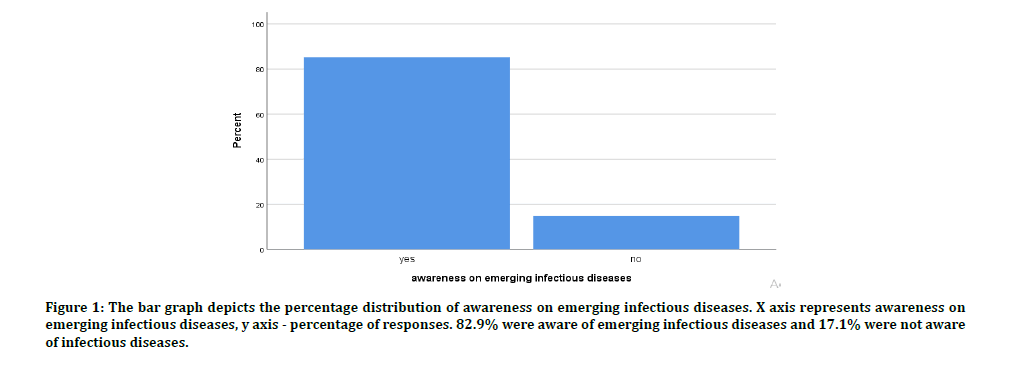
Figure 1: The bar graph depicts the percentage distribution of awareness on emerging infectious diseases. X axis represents awareness on emerging infectious diseases, y axis - percentage of responses. 82.9% were aware of emerging infectious diseases and 17.1% were not aware of infectious diseases.
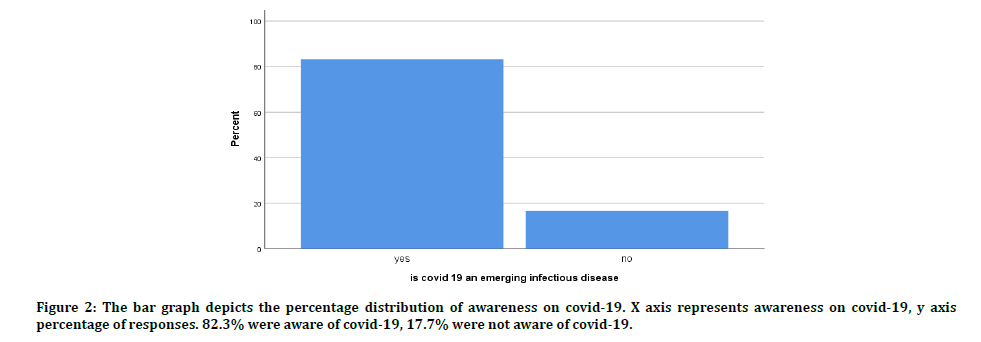
Figure 2: The bar graph depicts the percentage distribution of awareness on covid-19. X axis represents awareness on covid-19, y axis percentage of responses. 82.3% were aware of covid-19, 17.7% were not aware of covid-19.
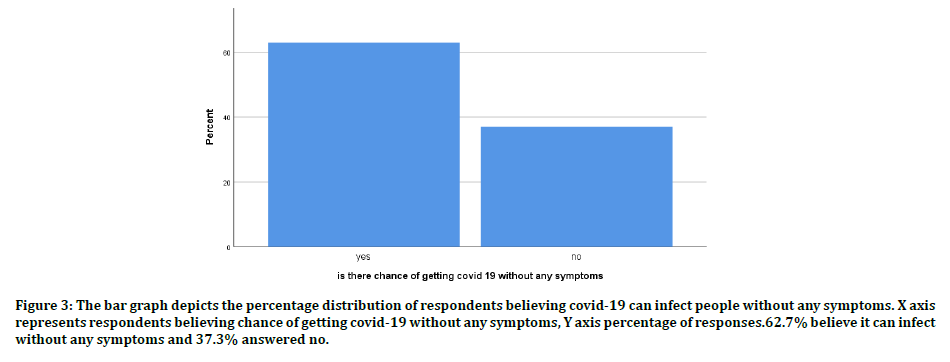
Figure 3: The bar graph depicts the percentage distribution of respondents believing covid-19 can infect people without any symptoms. X axis represents respondents believing chance of getting covid-19 without any symptoms, Y axis percentage of responses.62.7% believe it can infect without any symptoms and 37.3% answered no.
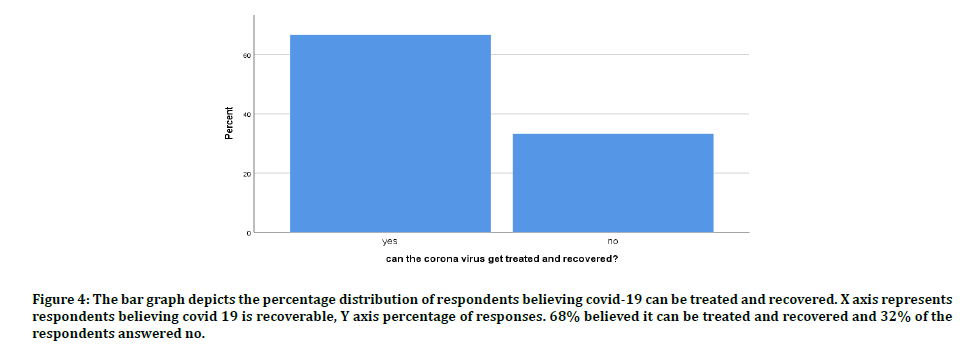
Figure 4: The bar graph depicts the percentage distribution of respondents believing covid-19 can be treated and recovered. X axis represents respondents believing covid 19 is recoverable, Y axis percentage of responses. 68% believed it can be treated and recovered and 32% of the respondents answered no.
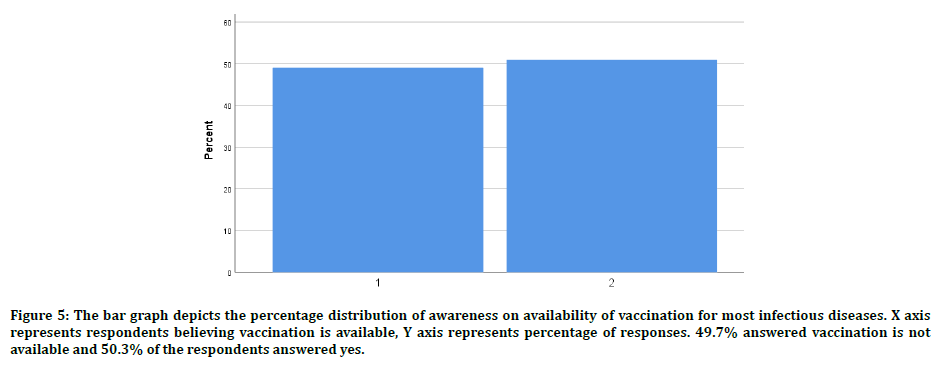
Figure 5: The bar graph depicts the percentage distribution of awareness on availability of vaccination for most infectious diseases. X axis represents respondents believing vaccination is available, Y axis represents percentage of responses. 49.7% answered vaccination is not available and 50.3% of the respondents answered yes.
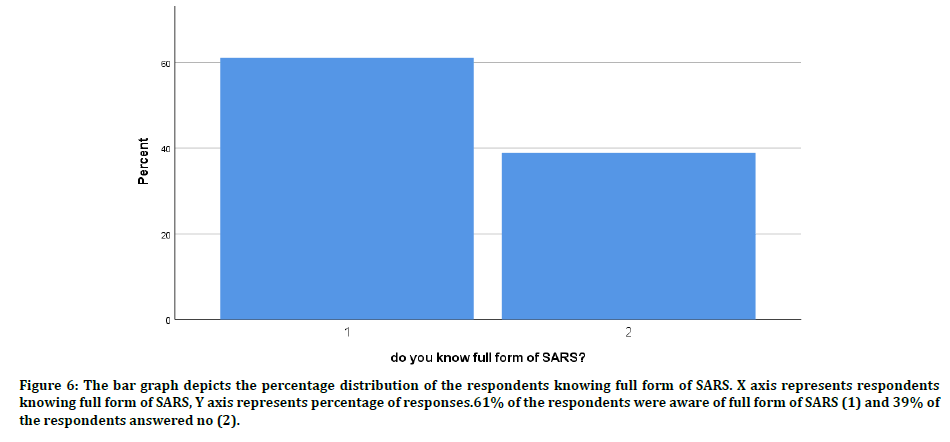
Figure 6: The bar graph depicts the percentage distribution of the respondents knowing full form of SARS. X axis represents respondents knowing full form of SARS, Y axis represents percentage of responses.61% of the respondents were aware of full form of SARS (1) and 39% of the respondents answered no (2).
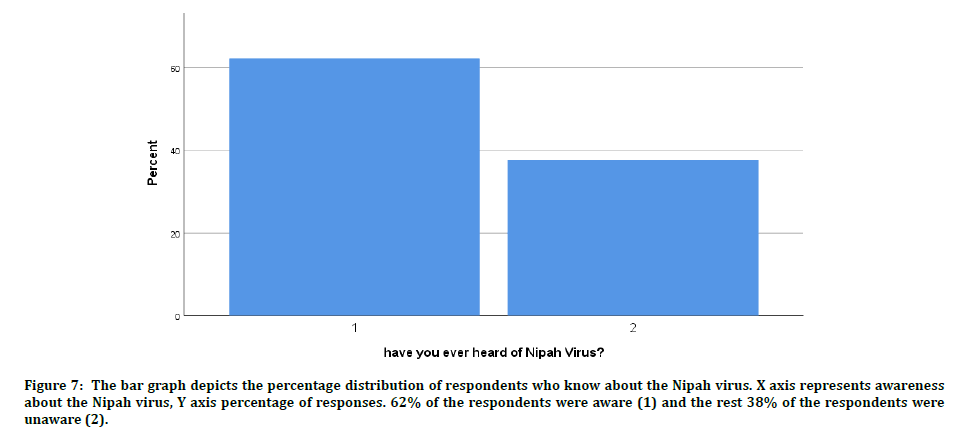
Figure 7: The bar graph depicts the percentage distribution of respondents who know about the Nipah virus. X axis represents awareness about the Nipah virus, Y axis percentage of responses. 62% of the respondents were aware (1) and the rest 38% of the respondents were unaware (2).
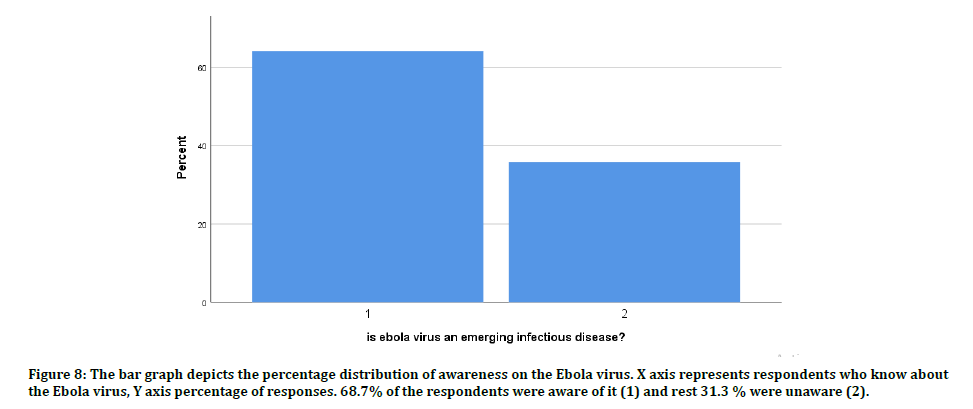
Figure 8: The bar graph depicts the percentage distribution of awareness on the Ebola virus. X axis represents respondents who know about the Ebola virus, Y axis percentage of responses. 68.7% of the respondents were aware of it (1) and rest 31.3 % were unaware (2).
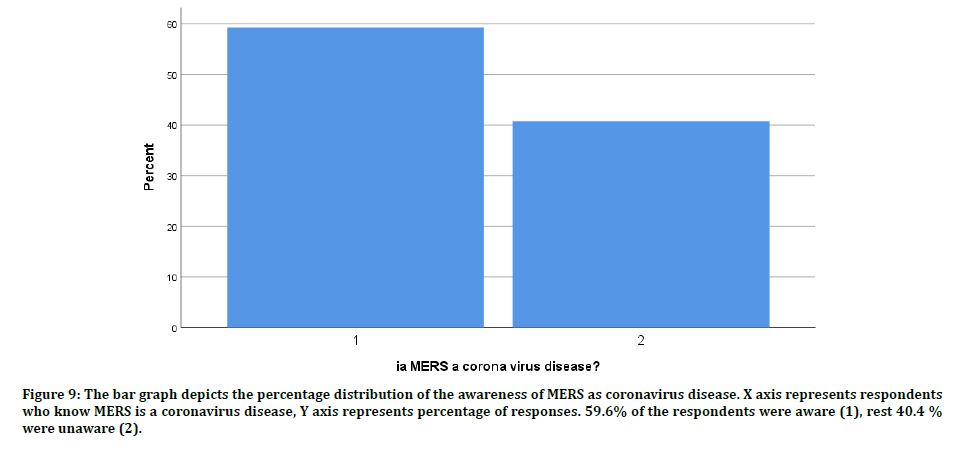
Figure 9: The bar graph depicts the percentage distribution of the awareness of MERS as coronavirus disease. X axis represents respondents who know MERS is a coronavirus disease, Y axis represents percentage of responses. 59.6% of the respondents were aware (1), rest 40.4 % were unaware (2).
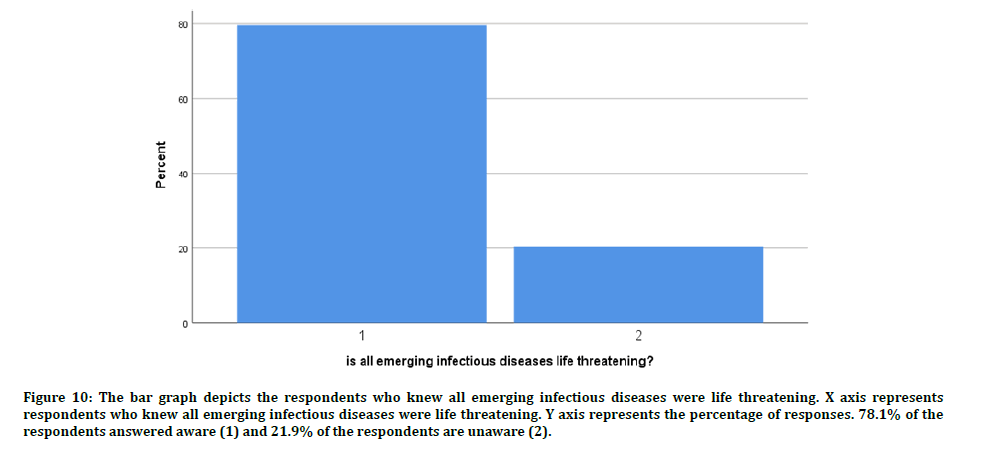
Figure 10: The bar graph depicts the respondents who knew all emerging infectious diseases were life threatening. X axis represents respondents who knew all emerging infectious diseases were life threatening. Y axis represents the percentage of responses. 78.1% of the respondents answered aware (1) and 21.9% of the respondents are unaware (2).
The association between gender and awareness on emerging infectious diseases is shown in Figure 11. Females are more aware than males. Chi square test having p value 0.179 (p>0.05), it is statistically not significant. In Figure 12, it shows the association between gender and knowledge on covid-19 as emerging infectious disease, females is more aware than males. Chi square test showing p value 0.179 (p value>0.05), it is statistically not significant.
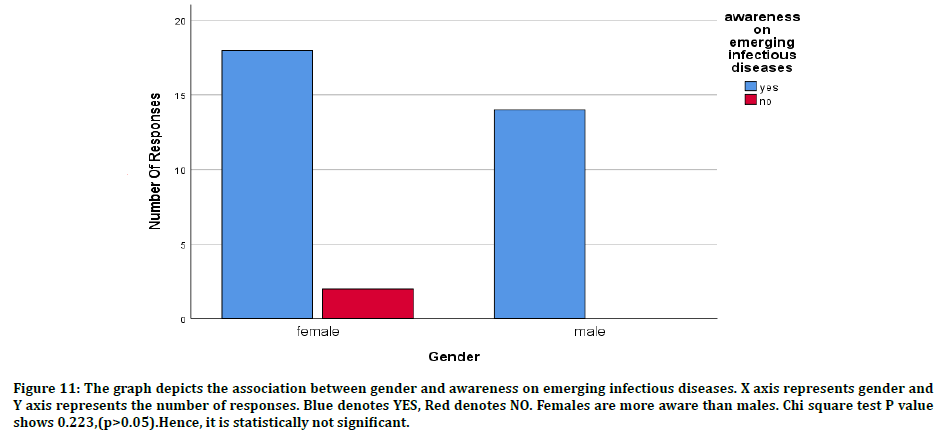
Figure 11: The graph depicts the association between gender and awareness on emerging infectious diseases. X axis represents gender and Y axis represents the number of responses. Blue denotes YES, Red denotes NO. Females are more aware than males. Chi square test P value shows 0.223,(p>0.05).Hence, it is statistically not significant.
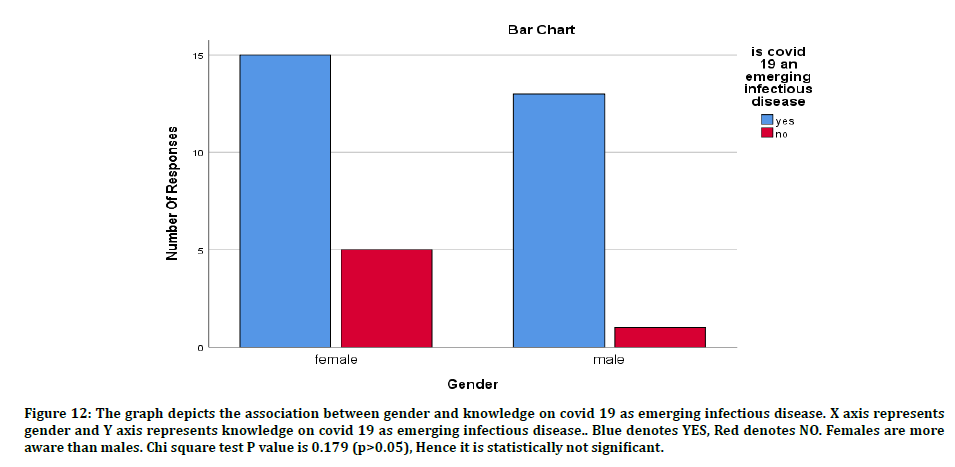
Figure 12: The graph depicts the association between gender and knowledge on covid 19 as emerging infectious disease. X axis represents gender and Y axis represents knowledge on covid 19 as emerging infectious disease.. Blue denotes YES, Red denotes NO. Females are more aware than males. Chi square test P value is 0.179 (p>0.05), Hence it is statistically not significant.
The association between gender and knowledge on getting affected by coronavirus without any symptoms is shown in (Figure 13), females are more aware than males. Chi square test having p value 0.393 (p>0.05), it is statistically not significant. The association between gender and knowledge on treatment and recovery from corona virus is shown in Figure 14, females are more aware than males. Chi square test having p value 0.966(p value>0.05), it is statistically not significant.
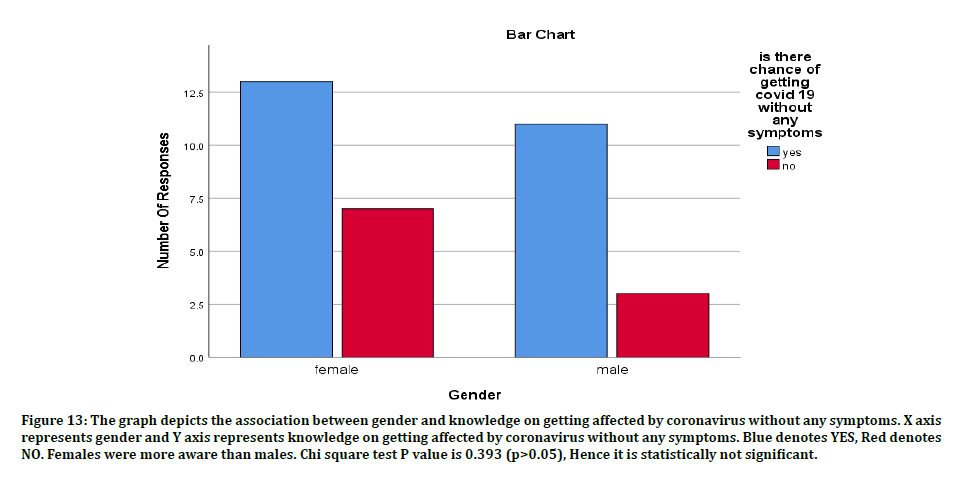
Figure 13: The graph depicts the association between gender and knowledge on getting affected by coronavirus without any symptoms. X axis represents gender and Y axis represents knowledge on getting affected by coronavirus without any symptoms. Blue denotes YES, Red denotes NO. Females were more aware than males. Chi square test P value is 0.393 (p>0.05), Hence it is statistically not significant.
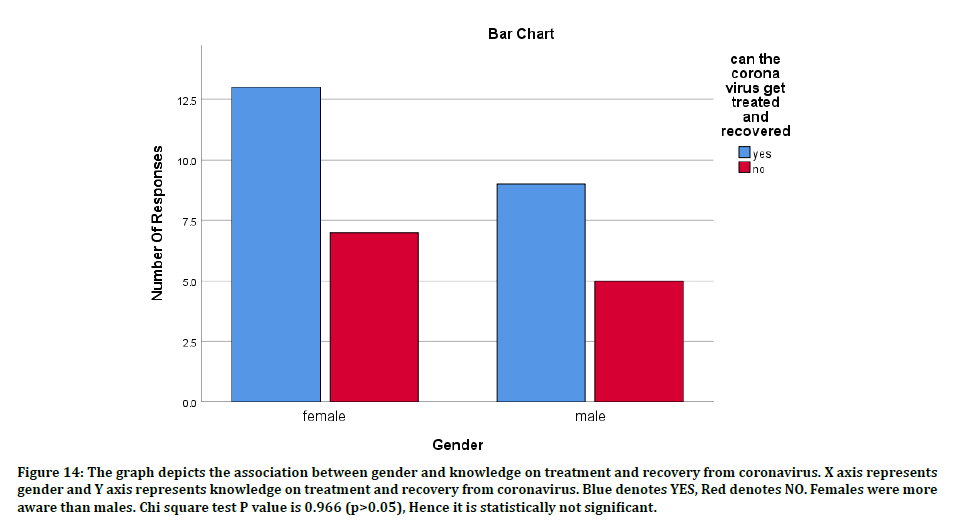
Figure 14: The graph depicts the association between gender and knowledge on treatment and recovery from coronavirus. X axis represents gender and Y axis represents knowledge on treatment and recovery from coronavirus. Blue denotes YES, Red denotes NO. Females were more aware than males. Chi square test P value is 0.966 (p>0.05), Hence it is statistically not significant.
In the present study, most of the respondents are aware of emerging infectious disease (82.9%). In a similar kind of study, 82.3% of the respondents responded positively that they are aware that covid 19 is an emerging infectious disease [21]. In this study, 68.7% knew what nipah virus is. In a similar kind of study, most of the people did not know about the nipah virus [22]. In this study, respondents who believe covid 19 can enter the body without any symptoms were about 66.7%. In a similar kind of study by Canning et al. they got results supporting the present study [23].
Respondents who believe vaccination is available for coronavirus were just 49.3%. But in a similar kind of study, majority were aware that there is no vaccination available [24]. In the present study, the majority of the respondents (76.1%) knew all emerging infectious diseases are life threatening. In a study conducted in 2002 byParola, et al. majority of respondents believed that all emerging infectious diseases are not life threatening [25].
Conclusion
The present study concludes that the majority of dental students are aware of the emerging infectious diseases. The study was useful in creating much awareness on emerging infectious disease.
Conflict of Interest
Conflict of interest declared as none.
References
- Pugliese G. NIOSH to expand research on workplace transmission of infectious diseases. Infect Infect Control Hosp 1993; 14:179–179.
- Woolhouse MEJ, Gowtage-Sequeria S. Host range and emerging and reemerging pathogens. Emerg Infect Dis 2005; 11:1842–1847.
- Sorrell T. Emerging infectious diseases. Lancet Infectious Diseases. 2011; 11:905.
- Taylor LH, Latham SM, Woolhouse ME, et al. Risk factors for human disease emergence. Philos Trans R Soc Lond B Biol Sci. 2001; 356:983–989.
- McMichael AJ. Environmental and social influences on emerging infectious diseases: Past, present, and future. SARS. 2005; 4–15.
- Samuel AR, Devi MG. Geographical distribution, and occurrence of endemic goitre research. J Pharm Tech 2015; 8:973.
- Baheerati MM, Gayatri Devi R. Obesity in relation to Infertility Research. J Pharm Tech 2018; 11:3183.
- Fathima F, Preetha P. Evaluation of thyroid function test in obese patients. Asian J Pharm Clin Res 2016; 11:353.
- Rj IRGD. Role of environmental factors on sleep patterns of different age groups. Asian J Pharm Clin Res 2016; 9:124.
- Harsha L, Priya J, Shah KK, et al. Systemic approach to management of neonatal jaundice and prevention of kernicterus. Res J Pharm Technol 2015; 9:1087.
- Dave PH, Preetha. Pathogenesis and novel drug for treatment of asthma-A review research. Res J Pharm Technol 2016; 9:1519.
- Abigail, Abigail, Priya J, et al. Evaluation of muscular endurance among dentists. Indian J Public Health Res Dev 2019; 10:258.
- David, David, Jothi Priya A, et al. Physical fitness among the dental physician, dental undergraduates and postgraduates’ students. Indian J Public Health Res Dev 2019; 10:223.
- Shruthi M, Preetha S. Effect of Simple tongue exercises in habitual snorers. Res J Pharm Technol 2018; 11:3614.
- Choudhari S, Jothipriya MA. Non-alcoholic fatty liver disease. Res J Pharm Technol 2016; 9:1782.
- Iyer PK, Gayatri Devi R, Jothi Priya A, et al. A survey study on causes, treatment, and prevention of onychocryptosis. Indian J Public Health Res Dev 2019; 10: 807.
- Sethu G. Evaluation of adenoids by oronasal and nasal spirometry. Asian J Pharm Clin Res 2018; 11:272.
- Swathy S, Sethu VG. Acupuncture and lower back pain. J Adv Pharm Technol Res. 2015; 8:991.
- Renuka S, Sethu G. Regeneration after myocardial infarction. Res J Pharm Technol 2015; 8:738.
- Timothy CN, Gayatri Devi R, Jothi Priya A, et al. Evaluation of peak expiratory flow rate (PEFR) in pet owners. Indian J Public Health Res Dev 2019; 10:803.
- Rajbhar P, Singh D, Yadav R, et al. Repurposing of SARS inhibitors against COVID 19. Chem Rixiv 2020; 1-9.
- Lai F, Chen Q. Humanized mouse models for the study of infection and pathogenesis of human viruses. Viruses 2018; 10:643.
- Canning D, Karra M, Dayalu R,et al. The association between age, COVID-19 symptoms, and social distancing behavior in the United States. Medrixiv 2020; 2:1-23.
- Dayal D, Gupta S. Connecting BCG vaccination and COVID-19: Additional Data. Medrixiv 2020; 2:1-9.
- Parola P, Raoult D. Ticks and tickborne bacterial diseases in humans: An emerging infectious threat. Clini Infect Dis 2001; 32:897–928.
Author Info
Mukil Sunil1, Preetha S1 and Lavanya Prathap2
1Department of Physiology, Saveetha Dental College, Saveetha Institute of Medical and Technical Sciences, Saveetha University, Chennai, India2Department of Anatomy, Saveetha Dental College, Saveetha Institute of Medical and Technical Sciences, Saveetha University, Chennai, India
Citation: Mukil Sunil, Preetha S, Lavanya Prathap, Knowledge and Awareness on Emerging Infectious Disease Spread among Dental Students, J Res Med Dent Sci, 2020, 8 (7): 204-211.
Received: 29-Sep-2020 Accepted: 26-Oct-2020 Published: 02-Nov-2020
